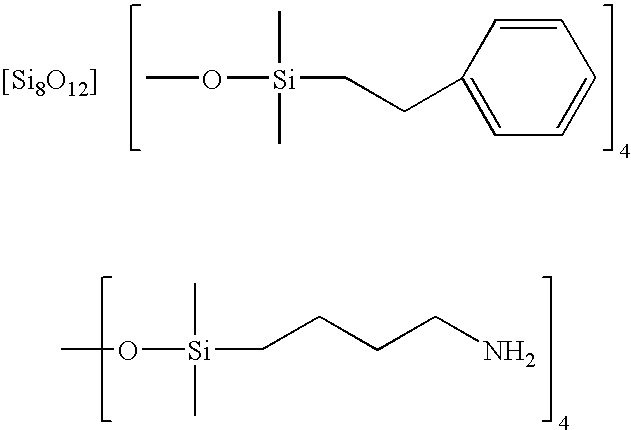Facile synthesis of polyhedral silsesquioxane anions and use thereof
a technology of silsesquioxane anions and polyhedrons, which is applied in the field of economically viable synthesis of silsesquioxane anions and their derivatives, can solve the problems of high cost of prior syntheses, time and energy consumption, and the expense of these starting materials preclude the use of silsesquioxane anions and derivatives, so as to reduce the amount of water, reduce the amount of chlorosilane-derived byproducts
- Summary
- Abstract
- Description
- Claims
- Application Information
AI Technical Summary
Benefits of technology
Problems solved by technology
Method used
Image
Examples
example 1
Synthesis of Si8O208− from Rice Hull Ash
[0034]A 45% methanolic choline hydroxide solution 9218 mL, 1.70 mol) is poured into a 1000 mL round-bottom flask containing milled rice hull ash (60.491 g, 0.998 mol), n-butanol (300 mL, 3.28 mol) and water (72.0 mL, 4.00 mol) equipped with a magnetic stirrer. The reaction vessel is also equipped with a condenser and flushed with nitrogen. The reaction mixture is heated to 100° C. for 8-12 h. The dark brown octaanion solution is filtered from the thick slurry of residual rice hull ash with celite. The residual rice hull ash is then washed several times with methanol (approximately 30 mL). Upon cooling, white crystals of the choline salt of the octaanion form. The solid crystals are filtered from solution, dried in air and can be recrystallized from hot water. Yield is determined by conversion to Si8O20[Si(CH3)3]8 as indicated below. The synthesis is not optimized.
[0035]Trimethylchlorosilane (21.8 mL, 0.1999 mol) and hexane (125.0 mL) are poure...
example 2
Synthesis of Si8O20[Si(CH3)2H]8 by the Stoichiometric Reaction of Si8O208− with Dimethylchlorosilane
[0036]A typical reaction is carried out as follows. Solid (2-hydroxyethyl) trimethylammonium silicate is prepared as above, and then dissolved in 1 mL of methanol. Si8O208− is the only silicate anion found in the methanol solution (SiO2 concentration 1.38 mol / L) and is stable in solution even 7 days after the preparation. Thus, the stoichiometric amount of dimethylchlorosilane required for producing Si8O20[Si(CH3)2H]8 from Si8O208− in the solution is calculated to 0.49 mL.
[0037]The methanol solution was added dropwise to a mixture of 3 mL of formic acid, 0.25 mL of hexane, and 0.49 mL of dimethylchlorosilane, which is stirred for 5 min for intimate mixing prior to the addition. The mixture is stirred for 1 h at 20° C. at ambient pressure. A portion of the product precipitates from the solution during the reaction. Hexane is added to the mixture after the reaction. The precipitates dis...
example 3
Synthesis of Si8O20[Si(CH3)2H]8 by Substitution of the Trimethylsilyl Group in Si8O20[Si(CH3)3]8 for the Dimethylsilyl Group
[0048]A typical reaction is carried out as follows. Si8O20[Si(CH3)3]8 (9.45 mg) is dissolved in 1,1,3,3-tetramethyldisiloxane (6.5 mL), followed by the addition of Amberlyst 15 cation-exchange resin (0.15 g). The 1,1,3,3-tetramethyldisiloxane solution of Si8O20[Si(CH3)3]8 is stirred vigorously for 26 h at room temperature under ambient pressure.
[0049]GC of the solution after 26 h gives one peak with a retention time of 12.5 min, while Si8O20[Si(CH3)3]8 (the starting material) gives a peak at 13.7 min. Amberlyst 15 cation-exchange resin is filtered off, and the filtrate is removed by rotary evaporation to obtain a transparent solid, soluble in usual organic solvents including tetrahydrofuran, acetone, and hexane. Two sharp signals appear at −3.00 and −110.34 ppm in the 29Si NMR spectrum of a tetrahydrofuran-d8 solution of the product, ascribable to the (SiO)3SiO...
PUM
| Property | Measurement | Unit |
|---|---|---|
| temperature | aaaaa | aaaaa |
| temperature | aaaaa | aaaaa |
| reaction time | aaaaa | aaaaa |
Abstract
Description
Claims
Application Information
 Login to View More
Login to View More - R&D
- Intellectual Property
- Life Sciences
- Materials
- Tech Scout
- Unparalleled Data Quality
- Higher Quality Content
- 60% Fewer Hallucinations
Browse by: Latest US Patents, China's latest patents, Technical Efficacy Thesaurus, Application Domain, Technology Topic, Popular Technical Reports.
© 2025 PatSnap. All rights reserved.Legal|Privacy policy|Modern Slavery Act Transparency Statement|Sitemap|About US| Contact US: help@patsnap.com



